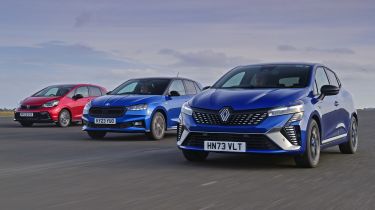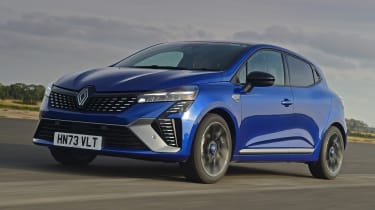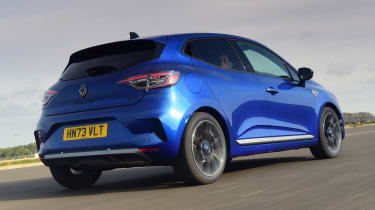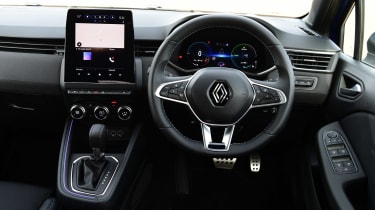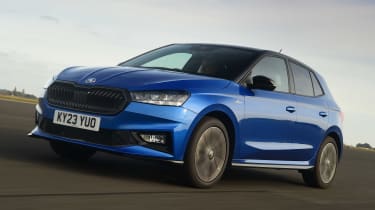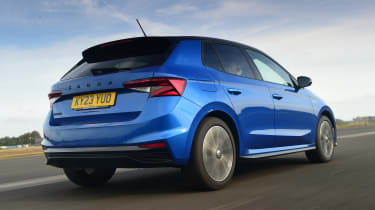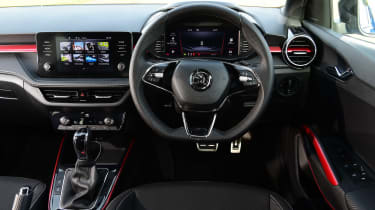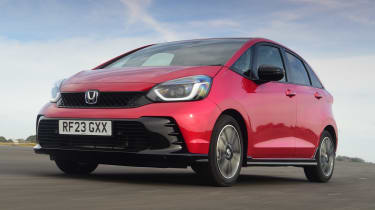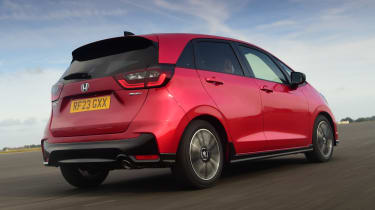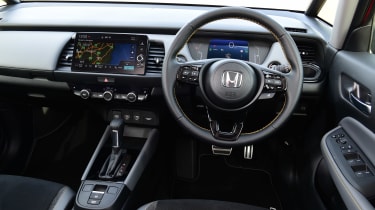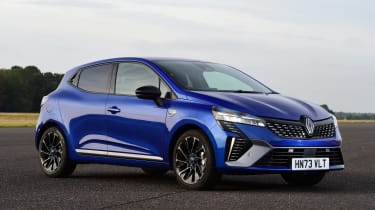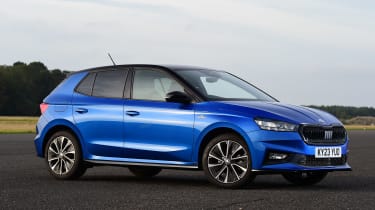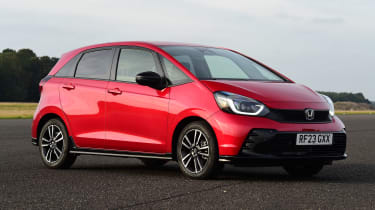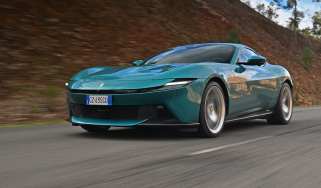Renault Clio vs Skoda Fabia vs Honda Jazz group test review: a battle for supermini supremacy
An update to the class-leading Renault Clio means a battle against the best that Skoda and Honda can offer
It’s hard to think of another segment of the new-car market that highlights the progress of the automotive industry so starkly as the supermini class. There has never been a time when these modest five-door hatchbacks have been so refined, spacious and packed with tech. In fact, we’d forgive you for wondering why most new-car buyers actually need anything more.
The Renault Clio has consistently been among our favourites since the fifth-generation model was released in 2019. Now, it’s been treated to a mid-life facelift, so we want to see what’s new with this hybrid version, and whether it’s still among the front runners in this segment.
To find out, we’ve lined up some very stern competition. The Skoda Fabia is a fantastic all-round supermini, and it should test the Renault’s driving manners and quality, even though it lacks a petrol-electric option under the bonnet. But is it needed? To cover the hybrid competition, we have the Honda Jazz, which also happens to be one of the most practical small cars that you can buy.
Renault Clio
| Model: | Renault Clio E-Tech Esprit Alpine |
| Price: | £24,095 |
| Powertrain: | 1.6-litre 4cyl HEV, 143bhp, multi-mode auto |
| 0-62mph: | 9.3 seconds |
| Efficiency: | 55.2mpg/12.1mpl |
| CO2: | 97g/km |
| Annual VED: | £170 |
The last Clio we group tested was a 1.0-litre petrol model in a mid-range trim level, and it emerged victorious. Will this revised car, in top-spec Esprit Alpine trim and with a hybrid powertrain (priced at £24,095), still come top?
Tech highlights
The revisions for the Clio focus on areas such as the styling, trim levels and equipment, which we’ll come to in the ownership section. Mechanically, the updated version is largely the same car as the model that has won the supermini class in our New Car Awards for three years in a row.
Used - available now

2023 MG
ZS EV
7,979 milesAutomaticElectric
Cash £14,366
2023 MG
ZS
18,009 milesAutomaticPetrol1.0L
Cash £13,825
2022 Mercedes
EQA
22,165 milesAutomaticElectric
Cash £21,700
2021 BMW
X4
45,365 milesAutomaticDiesel2.0L
Cash £25,500The hybrid powertrain is relatively complex. A 1.6-litre petrol engine is connected to not one, but two electric motors. The larger of these makes 48bhp, and is the one that does the work when the car is operating in full-electric mode. The second makes 20bhp, helps to fire up the engine, and matches the revs for the gearshifts to make them smoother, because there’s no clutch in the ‘Multimodal’ gearbox. The smaller motor also deals with brake regeneration, which in part helps to recharge the 1.2kWh battery.
Renault says that the hybrid system is capable of running in pure-electric mode for up to 80 per cent of the time when driving around town, which helps to reduce the Clio’s fuel consumption by as much as 40 per cent when compared with a non-hybrid petrol engine.
Safety: Renault boasts of the availability of 15 different Advanced Driver Assistance Systems on the latest version of its supermini. These include adaptive cruise control.
When the car was assessed by Euro NCAP in 2019, it was awarded a maximum five-star rating. Contributing to that was an impressive score of 96 per cent in the Adult Occupant category.
On the road
As an overall package, the Clio’s powertrain and chassis is one of the strongest in the segment. It doesn’t stand out in any one particular area, but it’s above average in most.
Around town: The hybrid system is at its best in town, where the petrol and electric power sources blend smoothly. If it wasn’t for a slight hum from the petrol engine, it would be very hard to notice when it wakes up and cuts out again.
The smoothness works with the Clio’s manners in general, with its light controls making it fairly easy to drive at low speeds. The electric motors do their most noticeable work from a standing start, giving the Clio sprightly pace from the off.
A & B-roads: The supermini segment is losing its best-handling car in the shape of the Ford Fiesta, but while the Clio can’t quite step into the Ford’s shoes in that respect, it’s still quite an enjoyable supermini to drive. The steering is sharp and the front end is willing to dive into a corner, while the Renault’s ride has enough forgiveness to deliver something that maintains its composure along a bumpy, twisty country road.
The powertrain is less suited to keen driving, however, because its performance is leisurely rather than rapid. And despite the smaller of the electric motors doing its best to fill in for the petrol engine’s sluggishness, it’s still possible
to catch the system off guard.
Motorway: Things settle down at high speeds, where the hybrid system feels more relaxing. The ride is soothing, yet stability remains strong, too. Road noise is fairly well contained, so for a car of this size, the Renault feels impressively at home on longer journeys.
Ownership
It's quite easy to distinguish the updated Clio from the old one, especially if you approach it from the front. The distinctive C-shaped daytime running lights make way for an even bolder LED lighting signature, in which a series of lit strips cascade down the outer edge of the front bumper.
Between the headlights, the grille has grown much wider than its predecessor, and it sits above a bolder Formula One-inspired blade that spans the width of the front end. New wheel designs and colours feature, while the rear end gets a subtle tweak to the design of the lights.
Inside, the updates are less extravagant, but there are new materials that aim to boost quality. The Clio already had one of the smarter interiors in this segment, and the clever use of fabrics around the cabin helps to add a feeling of quality that shouldn’t be taken for granted at this price point. Our Esprit Alpine trim also features fresh sports seats; some testers found that they might be a little too figure-hugging, but if the seats fit you, the side support and comfort are first rate. There’s plenty of adjustment for both the seat and the steering wheel, too.
Quite the opposite of first rate is Renault’s result in the latest Driver Power rankings. In the 2023 manufacturers’ list, the French brand finished 29th out of 31. One quarter of owners experienced a fault of some sort with their cars, although that is lower than several rival brands, including Skoda. All Renaults come with a three-year warranty and three years’ breakdown cover.
Practicality
By the general standards of the class, the Renault is above average for practicality. However, it comes up against two of the most spacious models in the segment here, and falls a little short.
Rear space: The Clio’s rear seats are perfectly fine for two people, and a soft centre seat means that it’s even fairly comfortable for those occasions when a third person needs to squeeze into the back. While kneeroom is above average for the class and there’s plenty of foot space, it’s behind its rivals here, and headroom is a little tight, too.
Boot: The hybrid tech means that the low boot floor you’ll find in a petrol Clio has been raised up by a significant amount. At 301 litres, the overall volume is a little disappointing, and the boot lip is high, too, which makes it harder to lift heavy items inside compared with its rivals.
Skoda Fabia
| Model: | Skoda Fabia 1.5 TSI Monte Carlo |
| Price: | £25,270 |
| Powertrain: | 1.5-litre 4cyl turbo, 148bhp, seven-speed auto |
| 0-62mph: | 7.9 seconds |
| Efficiency: | 42.1mpg/9.3mpl |
| CO2: | 125g/km |
| Annual VED: | £180 |
At £25,270, the Fabia sits slightly closer to the Clio in price than it does the Jazz. However, our test car added a range of optional extras that pushed the total up to £26,430, which is at the pricier end of the supermini spectrum, especially for a model without a hybrid powertrain.
Tech highlights
The Mk4 Fabia was released towards the end of 2021, and it received the Volkswagen Group’s latest MQB-A0 platform to put it on equal footing with the current VW Polo. The overall layout remains much the same as its predecessor’s, but the new architecture made it possible to improve refinement and introduce more in-car tech.
While the Honda is only available with a hybrid powertrain and the Clio will eventually be offered with a choice of pure-petrol and electrified options, the Fabia range goes without any sort of electrical assistance throughout. That means its powertrains are less complex, with the result that, for similar cash, you’re able to get a little more performance.
The car we have here is powered by the tried-and-tested 1.5-litre TSI four-cylinder engine that’s found in a wide range of VW Group products. In the compact Fabia, the 148bhp and 250Nm of torque it produces make it the most potent of this trio, while being the lightest, too. The gearbox is also fairly conventional beside its rivals here; there’s a seven-speed dual-clutch automatic that sends the engine’s torque to the front wheels.
Safety: The Skoda chalked up a maximum five stars when Euro NCAP tested it in 2020. There are a few too many features that are confined to the options list, though; a driver’s knee airbag and rear side airbags are available as part of the £510 Safety Package, but we’d prefer this potentially life-saving equipment to be installed as standard.
On the road
A mix of the most potent powertrain and Monte Carlo trim suggests the potential to deliver baby hot-hatch thrills, but this is no sharper than any other Fabia. That means the Skoda is comfortable, but a sluggish gearbox and a soft chassis remove any fun. The Renault’s handling is more engaging.
Around town: The lack of an electric motor is telling at low speeds, because there’s no hybrid tech to iron out the slight jerkiness of the Fabia’s dual-clutch gearbox. It’s most noticeable while parking, when the clutch can engage quite sharply, making it hard to gently creep in or out of a tight spot. That’s a shame, because the rest of the car’s controls feel sturdy and precise.
A & B-roads: The Skoda is the quickest of this trio. A 0-62mph time of 7.9 seconds is 1.4 seconds clear of the Clio’s, and gives the Fabia lots of punch regardless of the road you’re on. But it’s a shame that the gearbox isn’t quite as willing to keep up.
While the transmission is smooth enough at speed, it’s quite slow to kick down when you demand more power, and there aren’t any manual gearshift paddles to take control for yourself. Sport mode holds on to the gears for a little longer, but this still isn’t a car that you’d go for as a keen driver.
The same applies to the chassis, where the Skoda proves to be merely competent rather than fun. It’s less agile than the Renault, and its front end feels a little less grippy, too. The steering is precise enough, but doesn’t offer much feedback.
Motorway: At high speeds the Skoda is right at the top of the class. Motorway stability is on a par with the Renault, and ride comfort is similarly forgiving. In fact, it really feels like a much larger car on a long trip – in a good way.
Ownership
Skoda finished 20th in this year’s Driver Power manufacturer rankings, with owners loving the space and practicality of the brand’s range. But they were less enamoured with the occasional over-reliance on touchscreen functionality. Yet
it’s worth noting that, unlike on some of Skoda’s larger models, the Fabia’s air-con controls are adjusted via big, round knobs and large buttons.
The whole of the Fabia’s cabin design is clean and functional, and the main controls are located just where you’d expect them to be, so it’s an easy place to get familiar. The Monte Carlo trim lifts a gloomy black ambience with red trim highlights, which run along the dashboard and through the air vents, and on the gear selector surround and door pulls. The fake carbon-fibre material on the dash won’t be to everyone’s tastes, though. The Monte Carlo also gets a sportier three-spoke steering wheel with heavily perforated leather; it looks a little odd, but is grippy to hold.
All three of these competitors are well above the supermini average when it comes to the quality of their cabins, and the Skoda feels very solid overall.
As with the Renault, the Czech supermini comes with a three-year warranty, but here it has an unlimited mileage clause; the Clio is pegged to a (still lengthy) 60,000 miles. The Fabia also has three years of breakdown cover thrown in from the minute buyers leave the showroom.
The Fabia’s back seats have exposed Isofix mounts, which along with large rear doors that open wide, make it fairly easy to install a child seat.
Practicality
MPV-shaped Jazz aside, few superminis come close to offering he amount of space that the Fabia can provide.
Rear space: Kneeroom and headroom are both great in the Skoda, to the point where it’s better than many cars from the class above for carrying adults. Our only gripe is with the centre seat; despite a wide cabin that gives the most elbow room here, the middle backrest sits very proud of the main seats either side, so it’s not a very comfortable place to be.
Boot: A 380-litre boot capacity is the best here. Raise the floor to its highest point, and the rear seats drop to form a near-level load space. In two-seat mode, a generous 1,190-litre volume is available. A selection of hooks and elastic straps on the sides of the boot area is a useful touch, as is the rubber handle that allows you to pull the tailgate shut.
Honda Jazz
| Model: | Honda Jazz i-MMD Advance Sport |
| Price: | £27,915 |
| Powertrain: | 1.5-litre 4cyl HEV, 120bhp, eCVT auto |
| 0-62mph: | 9.5 seconds |
| Efficiency: | 59.5mpg/13.1mpl |
| CO2: | 104g/km |
| Annual VED: | £170 |
At £27,915 in range-topping Advance Sport trim, the Honda Jazz is the most expensive of this trio. However, it’s also the best equipped, and one or two colours aside, there are very few extras that will add to that figure.
Tech highlights
Mixing petrol and electric in the Jazz offers three distinct ways of driving the front wheels, depending on the type of road that you’re on.
Around town, it tries to operate in electric mode as much as possible, a process taken care of by a motor that offers up 121bhp and 253Nm. When the energy from the 0.86kWh battery is exhausted, a 1.5-litre petrol engine with 106bhp and 131Nm chimes in to add some extra shove, and the four-cylinder unit also spins up a second electric motor that can either add an electric boost or send excess energy back into the battery.
At motorway speeds, the most efficient way of moving the Jazz along the road is with the petrol engine only, according to Honda, so at this point it drives the wheels directly and the e-motor is no longer in play. Honda uses an eCVT transmission to bring all of these elements together; mid-life updates in 2023 aimed to make this system more responsive than in earlier models.
Safety: A total of 10 airbags are fitted as standard to every Jazz, which played its part in Euro NCAP awarding the little Honda a five-star rating when it was tested back in 2020.
The likes of traffic-sign recognition and lane- departure warning are standard on all models, while blind-spot detection, adaptive cruise control and cross-traffic monitoring are available on higher trim levels, including the Advance Sport.
On the road
The Jazz is an easy car to drive and its hybrid system is certainly seamless, but it still can’t quite match its rivals here.
Around town: The Jazz defaults to full-electric mode driving in the urban jungle, with the petrol engine only cutting in when the battery is low or if more power is needed.
When the four-cylinder unit does spark into life, it’s incredibly smooth. There’s no shunt from the powertrain, only a continuation of the same, easily modulated response. It feels like an EV.
A & B-roads: If and when you do ask for more power, the petrol engine isn’t quite so seamless. As with the Renault, there’s a noticeable pause between you asking for power and receiving it, and when you do, the Honda’s four-cylinder makes more noise than the Renault’s. The Jazz is marginally slower – 0-62mph takes two tenths of a second longer at 9.5 seconds – but in reality there’s little to separate the two.
There’s a bigger difference when you find a corner, though. Where the Clio feels fleet-footed, the Honda is rather ungainly. Its steering is a little slower (although nicely weighted) and the car feels slightly lazy through the turns. On the plus side, the Jazz has the most reassuring brakes here; the pedal is firm, the response is powerful and the transition between electric motor regeneration and the work from the brake discs and pads is almost impossible to pinpoint.
Motorway: At high speeds, the Jazz suffers from a little more wind noise than its two rivals, but it feels just as stable. The ride comfort, which is a little less settled than either the Clio or the Fabia around town, settles down on a motorway.
Ownership
Much like the slightly plain exterior styling, the dashboard of the Jazz doesn’t quite offer the pizzazz of its rivals’. Many of the plastics look a little flat and underwhelming, but the switchgear itself has an expensive feel to it.
The driving position is set a little higher than in the Renault or Skoda, and the base of the Honda’s windscreen slopes far forwards, which gives a roomy feel to the cabin up front. Large glass quarter panels ensure that visibility is maintained; combined with a relatively short bonnet, it’s quite easy to see out. The Advance Sport trim features yellow stitching on the seats, the steering wheel and door panels, to add a subtle dose of colour to the grey and black colour scheme.
Of the three brands in this contest, Honda fared the best in our 2023 Driver Power survey. While 18th position overall falls just short of a mid-table result, only 15 per cent of Honda buyers experienced a fault of some sort, which makes it among the six least problematic brands. Of that relatively small number of faults, electrical issues are most likely to be the cause – the same applies to both Renault and Skoda. In-car tech is an area where Honda hasn’t yet reached equal footing with its rivals, say owners; and we’re inclined to agree.
Practicality
It isn’t just the boxy shape that makes the Jazz the most practical supermini around; Honda has made the best use of that space with a clever rear-seat design, too.
Rear Space: Interior space is fantastic, with the Jazz beating its two competitors here for both kneeroom and headroom. The flat floor makes the area feel more spacious, too, but the gentle upward slope towards the front restricts foot room, and the centre seat is high and narrow.
Boot: The folding rear bench is brilliantly designed. The bases can flip up to make it possible to carry long, tall items in the back-seat area, or their double-hinged arrangement means that they not only fold completely flat, but also drop down exceptionally low, too, to make the most of the tall roof line. The boot lip is also 129mm lower than the Renault’s and 52mm lower than the Skoda’s.
Results
Winner: Renault Clio
The Renault Clio was our Supermini of the Year multiple times before its facelift, and the subtle updates have only made it even better. The way it drives has barely changed, so you still benefit from a great blend of a smooth ride and keen handling, while the hybrid system sips fuel around town. In most areas, the Clio is either close to, or the best in its class, so the fabulous finance deals seal its win.
Runner-up: Skoda Fabia
Renault’s punchy PCP rates have often proved to be the clincher in a group test, and so it is here. The Skoda matches and even beats the Clio in some areas, but it can’t match the Renault’s value for money – even if you save cash by missing out on the range-topping engine we’re testing here. The Fabia’s comfort, refinement, performance and in-car tech are still hard to beat.
Third place: Honda Jazz
It takes third here, but the Jazz still has plenty to offer. That mini-MPV shape makes it the most versatile car in this contest, while the high driving position and excellent visibility mean it’s easy to drive. Its hybrid powertrain is more efficient and smoother than the Renault’s, too. So-so handling isn’t a big deal for a car in this class, but a high price is; this prevents the Jazz from being a contender for the win.
Specs and prices
| Renault Clio E-Tech esprit Alpine | Skoda Fabia Monte Carlo 1.5 TSI | Honda Jazz Advance Sport e:HEV | |
| On the road price/total as tested | £24,095/£24,695 | £25,270/£26,430 | £27,915/£27,915 |
| Residual value (after 3yrs/36,000) | £12,650 (52.50%) | £11,500 (45.51%) | £15,275 (54.72%) |
| Depreciation | £11,445 | £13,770 | £12,640 |
| Annual tax liability std/higher rate | £1,146.48/£2,293 | £1,466.10/£2,932.20 | £1,395.75/£2,791.50 |
| Annual fuel cost (10k/20k miles) | £1,288/£2,576 | £1,689/£3,378 | £1,195/£2,390 |
| Ins. group/quote/VED | 15/£896/£170 | 19/£882/£180 | 22/£1,251/£170 |
| Service costs (3 years) | £720 | £675 | £335 |
| Length/wheelbase | 4,053/2,583mm | 4,125/2,551mm | 4,089/2,517mm |
| Height/width | 1,440/1,798mm | 1,482/1,780mm | 1,526/1,814mm |
| Engine | 4cyl in HEV/1,598cc | 4cyl in/1,498cc | 4cyl in HEV/1,498cc |
| Peak power | 143bhp | 148bhp | 120bhp |
| Peak torque | 205Nm | 250Nm | 253Nm |
| Transmission | Multi-mode auto/fwd | 7-speed auto/fwd | eCVT auto/fwd |
| Fuel tank capacity/spare wheel | 39 litres/£300 | 40 litres/£345* | 40 litres/repair kit |
| Boot capacity (seats up/down) | 254/1,006 litres | 380/1,190 litres | 304/1,205 litres |
| Kerbweight/payload/towing weight | 1,323/435/655kg | 1,226/444/1,200kg | 1,230/460/500kg |
| Turning circle | 10.4 metres | 10.4 metres | 10.7 metres |
| Basic warranty/recovery | 3yrs (60k)/3 yrs | 3 yrs (60,000)/3 yrs | 3 yrs (unlimited)/3 yrs |
| Driver Power manufacturer position | 29th | 20th | 18th |
| Euro NCAP: Adult/child/ped./assist/stars | 96/89/72/75/5 (2019) | 85/81/70/71/5 (2021) | 87/83/80/76/5 (2020) |
| 0-62mph/top speed | 9.3 secs/112mph | 7.9 secs/138mph | 9.5 secs/108mph |
| Test economy/range | 55.2/474 | 42.1 | 59.5/524 |
| WLTP combined | 65.7mpg | 51.1mpg | 61.4mpg |
| WLTP combined | 14.5mpl | 11.2mpl | 13.5mpl |
| Actual/Claimed CO2/tax bracket | 118/97g/km/0.24 | 155/125g/km/0.30 | 110/104g/km/0.25 |
| Number of airbags/Isofix points | Six/three | Six/three | 10/two |
| Parking sensors/camera | F&r/yes | Rear/£710 | F&r/yes |
| Lane-keep assist/blindspot/AEB | Yes/yes/yes | Yes/no/yes | Yes/yes/yes |
| Climate control/adaptive cruise | Yes/yes | Two-zone/£510 | Two-zone/yes |
| Leather/heated seats/wheel | No/yes/no | No/£640 (seats and wheel) | No/yes/yes |
| Metallic paint/LED lights | £600/yes | Yes/yes | Yes/yes |
| Keyless entry & go/powered tailgate | Yes/no | £570*/no | Yes/no |
| Sat-nav/digital dashboard/USBs | Yes/yes/two | £1,110/yes/two | Yes/yes/four |
| Online services/wireless charging | Yes/yes | Yes/£570* | Yes/yes |
| Apple CarPlay/Android Auto | Yes/yes | Wireless/yes | Wireless/yes |

